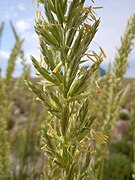Leymus cinereus
| Leymus cinereus | |
|---|---|

| |
| Scientific classification | |
| Kingdom: | Plantae |
| Clade: | Tracheophytes |
| Clade: | Angiosperms |
| Clade: | Monocots |
| Clade: | Commelinids |
| Order: | Poales |
| Family: | Poaceae |
| Subfamily: | Pooideae |
| Genus: | Leymus |
| Species: | L. cinereus
|
| Binomial name | |
| Leymus cinereus | |
| Synonyms | |
| |
Leymus cinereus is a species of wild rye known by the common names basin wild rye,[2] Great Basin wild rye,[3] and Great Basin lyme grass.[1] It is common in western North America.
Description
[edit]Leymus cinereus is a perennial bunchgrass forming large, tough clumps up to about 2 metres (6+1⁄2 feet) tall[4] and sometimes exceeding 1 m (3+1⁄2 ft) in diameter. It has a large, fibrous root system and sometimes small rhizomes.
The inflorescence is an unbranched, cylindrical spike divided into up to 35 nodes with several flower spikelets per node.
Distribution and habitat
[edit]Leymus cinereus is a common native grass of western North America, including western Canada and the United States from California to Minnesota. It grows in many types of habitat, including grassland and prairie, forests, scrub, chaparral, and sagebrush.[2][5]
The species can be found in moist, semi-alkaline flats.[4] In salt flats, it is replaced by Distichlis stricta.[4]
Ecology
[edit]The species may hybridize with Leymus triticoides,[6] Leymus salina, and Elymus elymoides.[7]
Uses
[edit]Native American groups had a variety of uses for the grass. The Okanagan and Colville used the roots medicinally to treat internal bleeding and gonorrhea and as a hair tonic. The Cheyenne burned the grass and mixed the ash with blood to make a black dye. Various groups used it for bedding, floor coverings, arrows, and basketry.[8]
Cultivars used in rangelands or site reclamation include 'Magnar' and 'Trailhead'.[7]
References
[edit]- ^ a b Leymus cinereus. NatureServe. 2012.
- ^ a b Leymus cinereus. USDA PLANTS.
- ^ "Leymus cinereus". Germplasm Resources Information Network. Agricultural Research Service, United States Department of Agriculture. Retrieved 12 January 2018.
- ^ a b c Taylor, Ronald J. (1994) [1992]. Sagebrush Country: A Wildflower Sanctuary (rev. ed.). Missoula, MT: Mountain Press Pub. Co. p. 70. ISBN 0-87842-280-3. OCLC 25708726.
- ^ Elymus cinereus. The Jepson Manual eFlora 2012.
- ^ Leymus cinereus. Archived 2016-03-04 at the Wayback Machine Grass Manual. Flora of North America.
- ^ a b Anderson, M. D. 2002. Leymus cinereus. In: Fire Effects Information System, USDA Forest Service, Rocky Mountain Research Station, Fire Sciences Laboratory.
- ^ Leymus cinereus. Native American Ethnobotany. University of Michigan, Dearborn.



